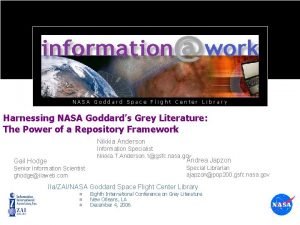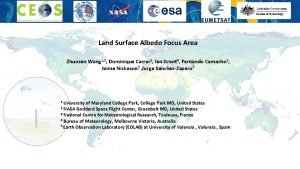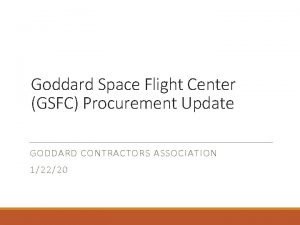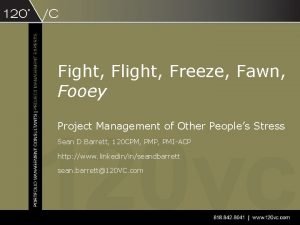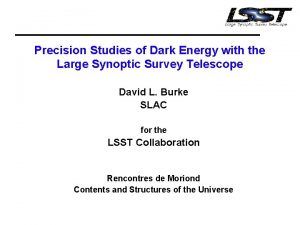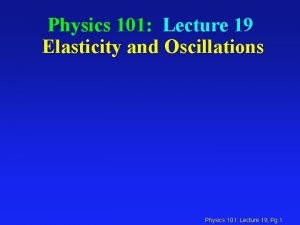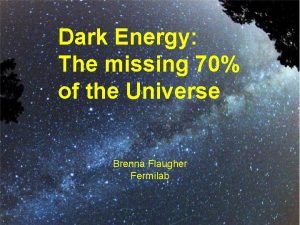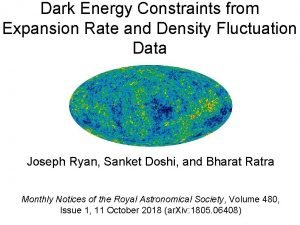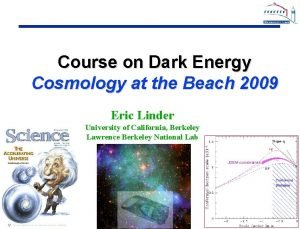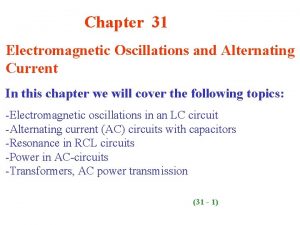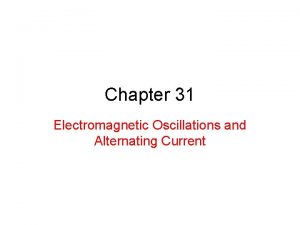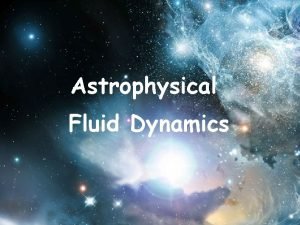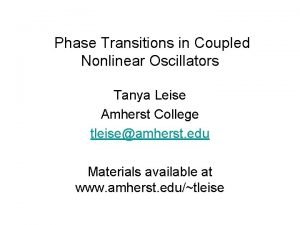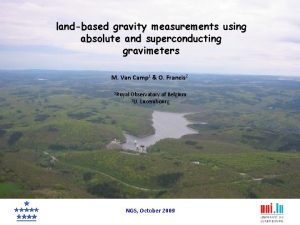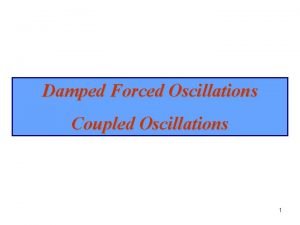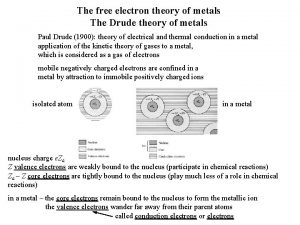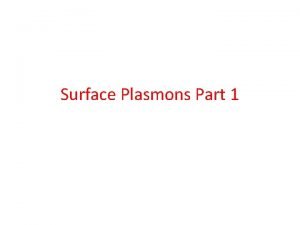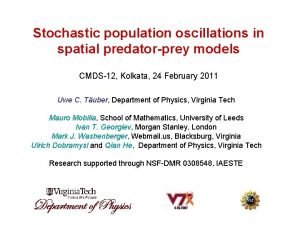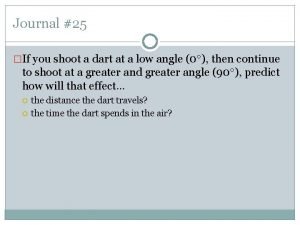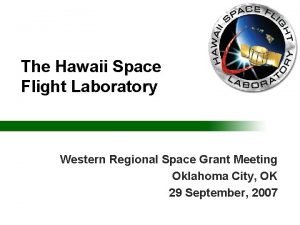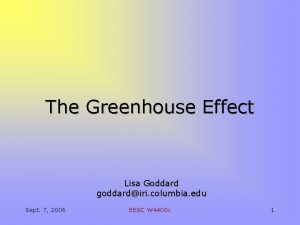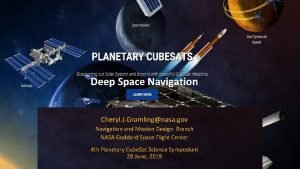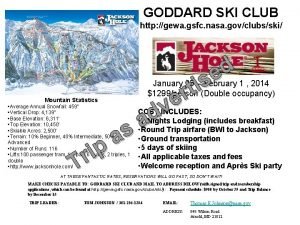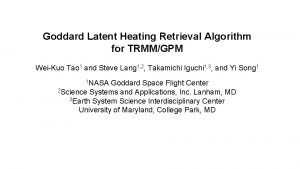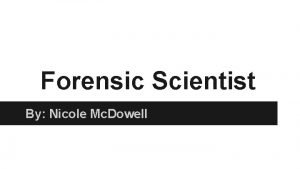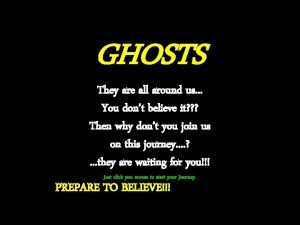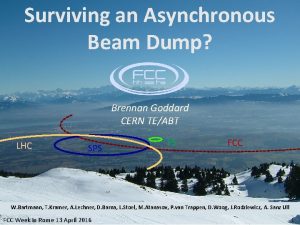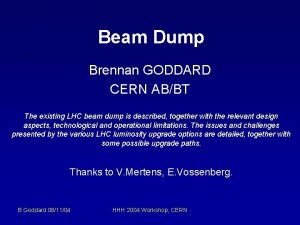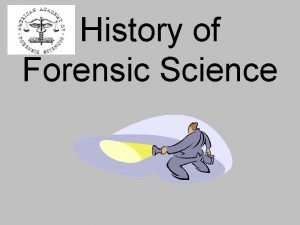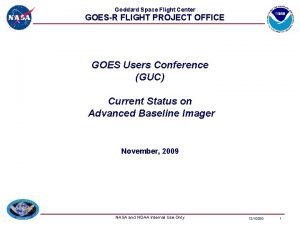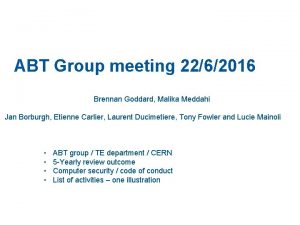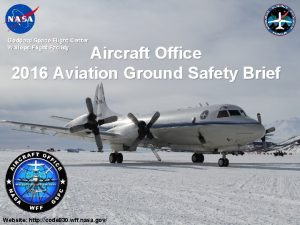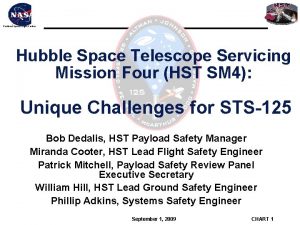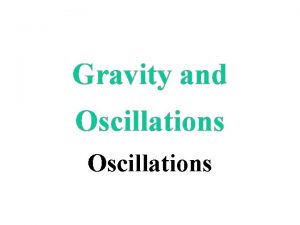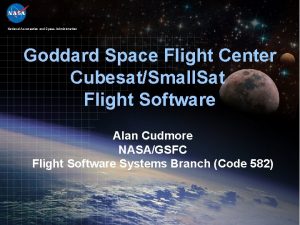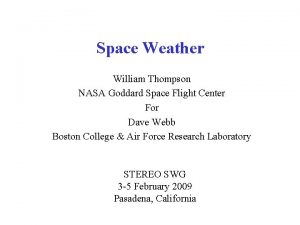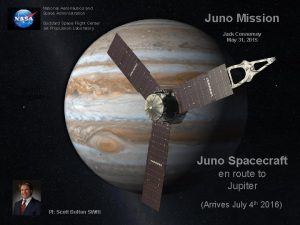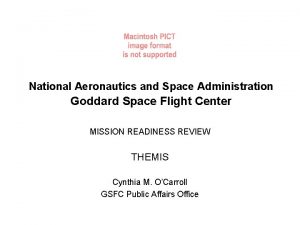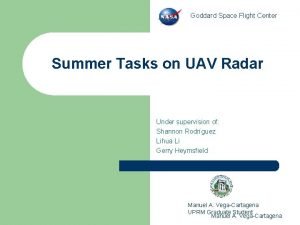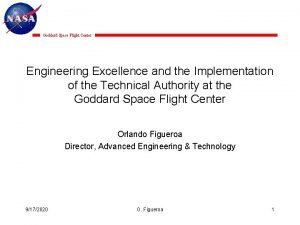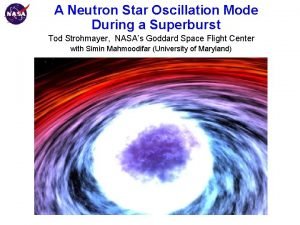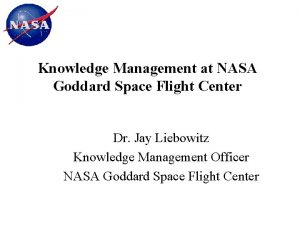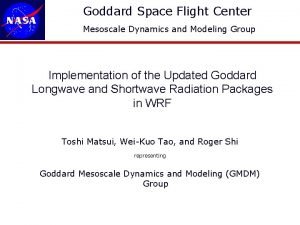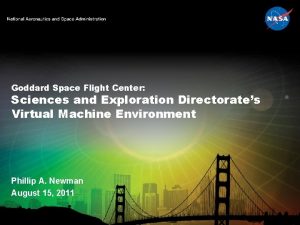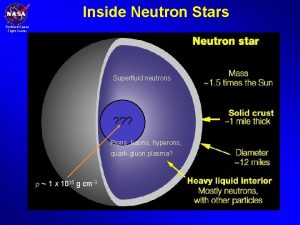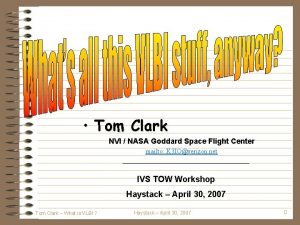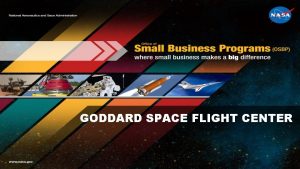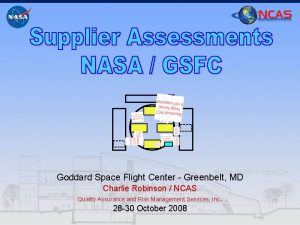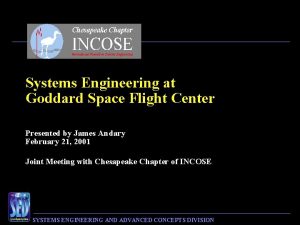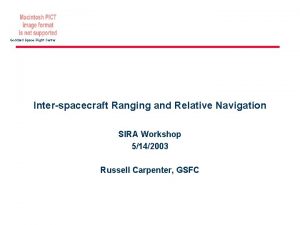Goddard Space Flight Center Fast Xray Oscillations During


































- Slides: 34

Goddard Space Flight Center Fast X-ray Oscillations During Magnetar Flares Three events to date: • March 5 th 1979: SGR 0526 -66 • August 27 th 1998: SGR 1900+14 • December 27 th 2004: SGR 1806 -20 Powered by global magnetic instability (reconfiguration), crust fracturing. Hurley et al. (1998): Ulysses • Short, hard, luminous initial pulse. • Softer X-ray tail persists for minutes, pulsed at neutron star spin period. • Emission from a magnetically confined plasma. • 1015 G magnetic fields implied (Thompson & Duncan 95)

Goddard Space Flight Center NASA’s Rossi X-ray Timing Explorer (RXTE) Launched in December, 1995, in orbit for 11. 5 yr! 12 th Observing cycle currently underway http: //heasarc. gsfc. nasa. gov/docs/xte_1 st. html RXTE’s Unique Strengths • Large collecting area • High time resolution • High telemetry capacity • Flexible observing

Goddard Space Flight Center SGR 1806 -20, 2004 December Giant Flare Israel et al. (2005)

Goddard Space Flight Center Oscillations in the 2004 December SGR 1806 -20 Flare • RXTE recorded the intense flux through detector shielding. • Israel et al. (2005) reported a 92 Hz quasi-periodic oscillation (QPO) during a portion of the flare. • Oscillation is transient, or at least, the amplitude time dependent, associated with particular rotational phase, and increased un-pulsed emission. • Also evidence presented for lower frequency signals; 18 and 30 Hz. • Suggested torsional vibrations of the neutron star crust. Israel et al. 2005

Goddard Space Flight Center A Look Back at the SGR 1900+14, 1998 August Flare • SGR 1900+14 flare was observed in a manner very similar to the SGR 1806 flare. • Same time resolution, but non-optimal read-out time resulted in data gaps. • Initially searched each good data interval as a whole. • 84 Hz QPO detected in 4 th data interval searched. The first after the pulse structure had re-emerged. • Strohmayer & Watts (2005)

Goddard Space Flight Center SGR 1900+14: 84 Hz signal • 84 Hz signal localized in time (rotational phase). • ~20 % (rms) amplitude • Not centered on a pulse peak. No other impulsive signals found, but what about weaker, persistent modulations?

Goddard Space Flight Center SGR 1900+14: Other QPO Signals • Computed average power spectra centered on the rotational phase of the 84 Hz QPO. • A sequence of frequencies was detected: 28, 53. 5, and 155 Hz! • Amplitudes in the 7 – 11% range. • Strong phase dependence: no signals detected from phases adjacent phase regions. • 4 frequencies in SGR 1900+14, a sequence of toroidal modes?

Goddard Space Flight Center SGR 1806 -20: RHESSI Confirmation of the Oscillations • Ramaty High Energy Solar Spectroscopic Imager (RHESSI) also detected the December, 2004 flare from SGR 1806 -20 (Hurley et al. 2005). • Timing study by Watts & Strohmayer (2006) confirms 92 Hz oscillation, and evidence for higher frequency (626 Hz) modulation.

Goddard Space Flight Center SGR 1806 -20: RHESSI Confirmation of the Oscillations • Timing study by Watts & Strohmayer (2006) reveals evidence for much higher frequency oscillation in SGR 1806 -20 flare, at 625 Hz. • Ramaty High Energy Solar Spectroscopic Imager (RHESSI) also detected the December, 2004 flare from SGR 1806 -20 (Hurley et al. 2005).

The SGR 1806 -20 Flare Re-visited Goddard Space Flight Center • Data now public. • Phase averaging of power spectra confirms strong 92 Hz QPO. • Used Phase averaging analysis as in SGR 1900+14 hyperflare. Detect several new frequencies.

The SGR 1806 -20 Flare Re-visited II Goddard Space Flight Center • Strong detection of 625 Hz signal in latter portions of the flare. • Evidence for higher frequencies too! Phase averaging reveals a 148 Hz QPO feature with high significance, but lower amplitude.

Goddard Space Flight Center The SGR 1806 -20 Flare Re-visited: Additional Oscillation Frequencies • SGR 1806 flare data now public. • Phase averaging of power spectra confirms strong 92 Hz QPO. Phase averaging also shows 625 Hz oscillation with high significance. Detected 200 – 250 s after initial spike.

Neutron Star Crusts: A Brief History Goddard Space Flight Center • Existence of a crust in a “normal” neutron star is not “controversial. ” Ruderman (1968) suggested that radio pulsations from the first pulsars were due to torsional vibrations of crust. • To good approximation crust is a Coulomb solid, that solidifies at G = (Ze)2 / ak. T > 175. • Implies shear modulus, m, scales as n(Ze)2 / a Piro (2005) • Ogata & Ichimaru (1990), Strohmayer et al. (1991) calculated m and explored oscillation mode implications. • Crust properties also linked with other observables, ie. Glitches and spin-down of pulsars, for example.

Shear Waves Goddard Space Flight Center Credit: Larry Braile, Purdue Univ.

Goddard Space Flight Center SGR 1900+14: Toroidal (torsional) Oscillation Modes • A neutron star crust supports shear (toroidal) modes. Purely transverse motions. Modes studied theoretically (Mc. Dermott, Van Horn & Hansen (1988), Schumaker & Thorne (1983), Duncan (1998), Strohmayer et al. (1991), Samuelsson & Andersson (2007). • Angular dependence of modes described by spherical harmonic functions (l, m); and a radial eigenfunction (n), l tn • l gives the total number of nodal planes, and m the number of azimuthal planes. An l=7, m=4 toroidal mode (Anna Watts) n(2 t 0) = 29. 8 (R 10)-1 (1. 71 - 0. 71 M 1. 4/R 10)1/2 Hz (0. 87 - 0. 13 M 1. 4/R 102) n(lt 0) = n(2 t 0) [ l(l+1)/6 ]1/2 [1 + (B/Bm)2 ]-1/2

Goddard Space Flight Center The SGR 1806 -20 Flare: thickness of the crust Strohmayer & Watts (2006) • Frequencies at 625 Hz and higher are likely n > 0 modes. Detection of n = 0 and n = 1 constrains crust thickness! • For n = 0 modes, effective wavelength is R, for n > 0 it is DR, if Vs = constant, then fn=0 / fn>0 ~ DR/R.

Goddard Space Flight Center Torsional modes: shear modulus, magnetic fields, and mode periods Piro (2005) • 30 – 150 Hz frequencies are consistent with current estimates of n = 0 mode frequencies, with n > 0 modes above 600 Hz. Piro (2005) Speed of shear waves, Vs, set by the shear modulus. Vs ~ const (1, 000 km/sec) not too bad an approximation.

Goddard Space Flight Center Mode Excitation, the Earth Analogy • Crust fracture in general will excite global modes. • Many such modes observed in the days after the 2004 December Sumatra – Andaman great earthquake. • Spectrum of modes excited depends on fracture geometry, but non-trivial patterns possible. Park et al. (2005)

Implications for Neutron Star Structure Goddard Space Flight Center • Recently, Samuelsson & Andersson (2007) computed torsional modes in full GR (Cowling approximation). • Determine “allowed” regions in M - R plane that can match observe mode sequences in SGRs 1806 -20 and 1900+14. • Caveat: No magnetic field corrections at all.

Implications for Neutron Star Structure Goddard Space Flight Center Frequencies (Hz) 1. 29. 0 : 2 t 0 2. 92. 7 : 6 t 0 APR (A 18+UIX+ v) Sahu, Basu & Datta (1993) 3. 150. 3 : 10 t 0 4. 625. 5 : 1 t 1 5. : 2 t 1 6. 1837 : Determine “allowed” regions in M - R (B-field) plane that can match observed frequencies. Calculations in progress for a range of realistic EOS (Schwarz & Strohmayer 2008, in preparation). 1 t 4

Constraints on Quark Stars? Goddard Space Flight Center Watts & Reddy (2007) • Watts & Reddy (2007) investigated crusts on strange quark stars. • Computed torsional mode periods for thin nuclear crusts, and also quark nugget crusts. In general, such stars have thinner crusts. • Computed modes very difficult to reconcile with observed periods.

Time and Frequency Variations Goddard Space Flight Center • 90 Hz QPO shows rather complex temporal, phase, and frequency variations. • Amplitudes not constant in time (episodic). • Several factors could be at work; changes in field and particle distributions. Energy exchange with the core. Strohmayer & Watts 2006

Persistence of QPOs Goddard Space Flight Center

Theoretical Issues Goddard Space Flight Center • Recognized that magnetic coupling of crust with core will likely be significant. Need “global” mode calculations (Levin 2006; Glampedakis et al. 2006; Sotani et al. 2006). • Levin (2006) initially argued that torsional modes will radiate Alfven waves into the core and damp too quickly to be observed (~ 1 sec). • Feedback, energy exchange between crust and core (Levin 2007). • Excitation of modes in the crust, analogies with earthquake fractures. • We see modulations in the X-ray flux, can these be produced by crust motions. • Signal amplification, perhaps modest amplitudes are visible (beaming? )

Crust - Core coupling Goddard Space Flight Center • Levin argues that energy exchanges between the crust and a continuum of MHD modes in the core. • Solving initial value problem, finds QPOs excited at the so called “turning points” or edges of the MHD continuum. Lowest frequency modes (18, 25 Hz). Levin (2007) • Also finds drifting QPOs, and amplification of these features near pure crust mode frequencies.

X-ray Modulation Mechanism Goddard Space Flight Center Timokhin, Eichler & Lyubarsky (astro-ph/07063698) • Suggest that modulation of the particle number density in the magnetosphere by torsional motion of the crust produces the oscillations. • Estimate that 1% amplitude of crust motion needed to explain the observed QPO amplitudes. • The angular dependence of the optical depth to resonant Compton scattering may account for phase dependence.

Conclusions, and many questions! Goddard Space Flight Center • Detection of multiple frequencies with consistent l-scaling, and frequencies consistent with n>0 modes is highly suggestive of torsional oscillations, but need more data! • Two (three, March 5 th? ) out of three with similar phenomena, suggests fundamental property of magnetars. • Further understanding and detections could help constrain neutron star properties (EOS, and crust properties, magnetic fields). Unfortunately, giant flares are rare! • More theory needed: new mode calculations (with magnetic fields, etc. ) • How are modes excited and damped? How do the mechanical motions modulate the X-ray flux? • Could magnetic mode splitting be observed, constrain field geometry?

Inside Neutron Stars Goddard Space Flight Center Superfluid neutrons ? ? ? Pions, kaons, hyperons, strange quark matter, quark-gluon plasma? r ~ 1 x 1015 g cm-3 • The physical constituents of neutron star interiors still largely remain a mystery after 35 years.

Goddard Space Flight Center QCD phase diagram: New states of matter Rho 2000, thanks to David Kaplan • Aspects of QCD still largely unconstrained. • Recent theoretical work has explored QCD phase diagram (Alford, Wilczek, Reddy, Rajagopal, et al. ) • Exotic states of Quark matter postulated, CFL, color superconducting states. • Neutron star interiors could contain such states. Can we infer its presence? ?

Implications for Neutron Star Structure Goddard Space Flight Center • For SGR 1900+14, 28, 53. 5, 84, and 155 Hz sequence is plausibly consistent with l=2, 4, 7, 13 modes (n=0)! SGR 1806 • Mode frequencies depend on stellar mass, radius and magnetic field. • If modes correctly identified, then it places constraints on the stellar structure, though, with some caveats (such as magnetic field effects). SGR 1900 Strohmayer & Watts (2005)

Goddard Space Flight Center Magnetar hyper-flares: Whole lotta shakin’ goin’ on Tod Strohmayer, NASA’s Goddard Space Flight Center

Goddard Space Flight Center Fundamental Physics: Existence of New States of Matter? • Theoretical work suggests quark matter could exist in neutron stars, possibly coexisting with a nuclear component. • Mass – Radius measurements alone may not be enough to discriminate the presence of quark matter. Alford et al. (2005) • Other observables, such as global oscillations might be crucial.

Anatomy of a Hyperflare Goddard Space Flight Center Three events to date: Hurley et al. (1998): Ulysses • March 5 th 1979: SGR 0526 -66 • August 27 th 1998: SGR 1900+14 • December 27 th 2004: SGR 1806 -20 Powered by global magnetic instability (reconfiguration), crust fracturing. • Short, hard, luminous initial pulse. • Softer X-ray tail persists for minutes, and reveals neutron star spin period. • Emission from a magnetically confined plasma. • 1015 G magnetic fields implied (Thompson & Duncan 95)

The Neutron Star Equation of State Goddard Space Flight Center Lattimer & Prakash 2004 d. P/dr = -r G M(r) / r 2 • Mass measurements, limits softening of EOS from hyperons, quarks, other exotic stuff. • Radius provides direct information on nuclear interactions (nuclear symmetry energy). • Other observables, such as global oscillations might also be crucial.
 Goddard space flight center library
Goddard space flight center library Albedo
Albedo Goddard contractors association
Goddard contractors association Fight flight freeze fawn
Fight flight freeze fawn Baryon acoustic oscillations
Baryon acoustic oscillations Elasticity and oscillations
Elasticity and oscillations Grades of mobilization
Grades of mobilization Universe expanding faster should
Universe expanding faster should Baryon acoustic oscillations
Baryon acoustic oscillations Baryon acoustic oscillations
Baryon acoustic oscillations Electromagnetic oscillations and alternating current
Electromagnetic oscillations and alternating current Electromagnetic oscillation pdf
Electromagnetic oscillation pdf Baryonic acoustic oscillations
Baryonic acoustic oscillations Tanya leise amherst
Tanya leise amherst Slow oscillations
Slow oscillations Coupled pendulum
Coupled pendulum Drude model
Drude model Plasma oscillations
Plasma oscillations Lotka-volterra predator-prey model
Lotka-volterra predator-prey model Differentiate between acid fast and non acid fast bacteria
Differentiate between acid fast and non acid fast bacteria Example of acid-fast bacteria
Example of acid-fast bacteria Path of a projectile is
Path of a projectile is Space a flights to hawaii
Space a flights to hawaii Lisa goddard columbia
Lisa goddard columbia Cheryl gramling
Cheryl gramling Nasa goddard ski club
Nasa goddard ski club Goddard heating and air
Goddard heating and air Leone lattes biography
Leone lattes biography Fiona goddard age
Fiona goddard age Look around you ghosts
Look around you ghosts Brennan goddard cern
Brennan goddard cern Brennan goddard cern
Brennan goddard cern Calvin goddard contribution to forensic science year
Calvin goddard contribution to forensic science year Cheryl goddard
Cheryl goddard Malika meddahi cern
Malika meddahi cern
